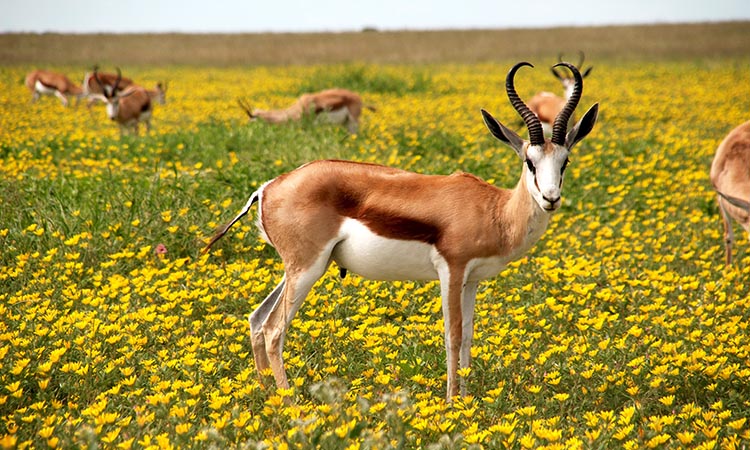It is well known that Africa has the second largest population in the world. The border area of the continent of Africa is 30.3 million km3.including adjacent islands. Africa covers 6% of the earth’s total surface area and 20% of its land area. With a 1.3billion population. It’s most population is 16% of the world population accounts. The most important other thing is, Africa has a wide range of natural resources. It includes diamond, sugar, salt, gold, iron, cobalt, uranium, copper, bauxite, silver, petroleum, cocoa beans, woods, tropical fruits, etc. In recent years, the African government discovers mineral resources. That is a reason for increasing African’s economics.
Different types of animals.
Africa is the best home for all category animals. Because Africa has a huge animal resource, some animals are big than other animals.
First, let’s know who they are? They called “BIG FIVE” is described as the power and strength of the animals. These animals were the most difficult and hard to be hunted on foot. So, that is a reason the term was created last century.
300 mammal species are living in South Africa. Some animals are the world’s tallest, fastest, or even tiniest animals, there are giraffe, the speedy cheetah or tiny pygmy shrew but several animal species are endangered such as the African wild dogs, African oribi or rhino especially Africa oribi or rhino are hunted by hunters their horn .it is one of the biggest problems in south African animal resources. Because of that, the African government and some private animal rescue associations kept and protected them. Conservation effort in South Africa is another plan for endangered animals. They have been successful in growing populations of the mountain zebra and bontebok, and antelope species. The plan only works in South Africa; Over 850 species of beautiful birds live in South Africa. Some species of birds can only be found here. Ostrich, kingfishers, sunbirds, and cane, these birds are can be seen in South Africa.
South Africa’s national symbol.
THE NATIONAL FLOWER – KING PROTEA
King Protea. Its Pink and colorings beautiful giant flower. If you want to see the king protea King., bloom then, there are some great places around cape town. You can see them.

THE NATIONAL TREE – REAL YELLOWWOOD
The Real yellowwood tress is a useful, beautiful timber because local artisans make beautiful furniture and creative wooden things. It can grow up to 40 m and up to 3 m in the Kirstenbosch Botanical Garden.
THE NATIONAL ANIMAL – SPRINGBOK.
The springbok is South Africans most well-known animal(antelope). This elegant mammal is a vegetarian—it grownup to 75cm in height. Springbok is the fastest animal, and it can reach a speed of more than 80km/antelope appearance is a white face, brown body, and white bottom of the leg. Therefore, they can be easily identity them from a distance.
.

If you want to see them, they can be found freely in cape point national park and South Africa’s game reserves.
| Antelope Scientific Classification | Antelope Locations |
| Kingdom Animalia Phylum Chordata Class Mammalia Order Artiodactyla Family Bovidae | Africa Asia Eurasia North-America |
Antelope Facts
| Main Prey Distinctive Feature Habitat Predators Diet Average Litter Size Lifestyle Favorite Food Type Slogan | Grass, Shoots, seeds Long legs and curved antlers Forest and grasslands Lion, Cheetah, Crocodile Herbivore 1 Herd Grass Mammal Renew their horns every year! |
Antelope Appearance
| Colour Skin Type Top Speed Lifespan Weight Height | Brown Red, Tan, Fur 43 mph 10 – 25 years 500kg – 900kg (1,100lbs – 2,000lbs) 1m – 1.5m (3 – 5ft) |
Antelope Conservation Status
Least Concern
THE NATIONAL FISH -GALJOEN
The galjoen fish is another South African national symbol. And They native to the coastal water of South Africa. Most live-in shallow water, and they especially popular in Kwa-Zulu Natal. Usually, it is called back bream or blackfish—the galjoen weight up to 7kg.
| Crane Scientific Classification | Crane Locations | |
| Kingdom Phylum Class Order Family Scientific Name | Animalia Chordata Aves Gruiformes Gruidae Gruidae | Africa Asia Eurasia Europe North America Oceania |
THE NATIONAL BIRD – BLUE CRANE.
Blue Crane, a Blue-grey bird, is only to be found in South Africa. This bird has got a long neck and long large, huge feathers. Normally they live in the karoo and can also be seen in Kwa – Zulu Natal and the highland. Everyone goes to cape town to see the blue crane. It’s a trendy place to see blue cranes.
Crane Conservation Status
Near Threatened
Crane Facts
| Main Prey Distinctive Feature Wingspan Habitat Predators Diet | Insects. Fish, Grain Large body size and long beak 1.8m – 2.4m (71in – 95in) Temperate wetlands Fox, Eagle, Wildcats Omnivore |
Crane Physical Characteristics
| Colour Skin Type Top Speed Lifespan Weight Length | Colour Skin Type Top Speed Lifespan Weight Length |
Lion (AFRICAN LION)
| Lion Scientific Classification | Lion Locations |
| Kingdom Animalia | AFRICA |
| Phylum Chordata | ASIA |
| Class Mammalia Order Carnivora Family Felidae Genus Panthera Scientific Name Panthera leo |
Lion Facts
| Prey | Antelope, Warthog, Zebra |
| Name Of Young | Cub |
| Group Behavior | Pride |
| Fun Fact | Lives in small groups called prides! |
| Estimated Population Size | 23,000 |
| Biggest Threat | Habitat loss |
| Most Distinctive Feature | Long and thick hairy mane of the male around the face |
| Other Name(s) | African Lion |
| Gestation Period | 110 days |
| Habitat | open woodland, scrub, grassland |
| Predators | Human |
| Diet | Carnivore |
| Average Litter Size | 3 |
| Lifestyle | Diurnal/Nocturnal |
| Common Name | Lion |
| Number Of Species | 2 |
| Location | sub-Saharan Africa |
| Slogan | Lives in small groups called prides! |
| Group | Mammal |
Lion Appearance
| Color Skin Type Top Speed Lifespan Weight Length Age of Sexual Maturity Age of Weaning | Brown, Tawny, Gold, Blonde Fur 35 mph 8 – 15 years 120kg – 249kg (264lbs – 550lbs) 1.4m – 2.5m (4.7ft – 8.2ft) 2 – 3 years 6 months |
The is one of the largest, stronger, and powerful animal categories in the world. The size of the lion is second only to that of Siberian Tigers. There are two types of lion’s category The African lion and the Asiatic lion. African lion’s scientific name is PANTHERA LEO MELANOCHAITA.
African lions have powerful jaws and teeth. That contains 30 teeth in including four fang-like canines and four carnassial teeth. They are using for perfectly designed for slicing through flesh. Lion appearance, they have short coats and golden fur with a long tail. Lion’s coat has bold stripes and sports displayed.
They can inhabit arid climates. They live like that to make it easier for them to get food. They prefect to live areas of open woodland, shrub, and long grasslands. But lions are only not found I areas of rainforest or desert. And lion population, the IUNC’s last assessment, adult lion population between 23,000 to 39,000 mature individuals. But today, the lion as a species is listed as ‘vulnerable’ and endangered.
AARDVARK
Aardvark Scientific Classification
| Kingdom Phylum Class Order Orycteropodidae Orycteropus Orycteropus afer | Animalia Chordata Mammalia Tubulidentata Family Genus Scientific Nam |
Aardvark facts
| Prey | Termites, Ants |
| Name Of Young | Cub |
| Group Behavior | Solitary |
| Fun Fact | Can move up to 2ft of soil in just15 seconds! |
| Estimated | Unknown |
| Most Distinctive Feature | Long, sticky tongue and rabbit-like ears |
| Other Name(s) | Antbear, Earth Pig |
| Gestation Period | 7 months |
| Habitat | Sandy and clay soil |
Aardvark Physical Characteristics
| Predators Diet Average Litter Size Lifestyle Common Name Number of Species Location Slogan Color Skin Type Top Speed Lifespan Weight Length Age of Sexual Maturity Age of Weaning | Lions, Leopards, Hyenas Omnivore 1 Nocturnal Aardvark 18 Sub-Saharan Africa Can move 2ft of soil in just 15 seconds! Mammal Brown, Grey, Yellow Hair 25 mph 23 years 60kg – 80kg (130lbs – 180lbs) 1.05m – 2.20m (3.4ft – 7.3ft) 2 years 3 months |
Aardvark Location
Africa
Aardvark is a small pig. They look like mammals, and they were found in a wide range of different habitats throughout Africa, south of Sarah. They live a lonely life and spend their time together sleeping in underground borrows because they can protect themselves from the African sun’s heat. In the cooler evening of the day, they are searching for food. They have a long snout and pig-like body. Their name originates from the African languages in South Africa, which means Earth pig. Aardvarks are unique among animals. Because they are the surviving species in their animal’s family. But in recent days, some zoologists were believed they were most closely related to other insectaries such as armadillos and pangolins. But other people believe aardvark was relative to the elephant family.
They all are medium-sized with thick skin that can protect them from the hot sun and from being harmed by an insect, their nose, or rabbit-like ears that can but open in the ground. Still, they can prevent flooded flats from entering their ears. Aardvark has strong claws on their spade-like feet that their front hind legs are longer than their front legs. Aardvark is found in a different habitat throughout sub-Saharan African, from deserts to the most rain forest reigns. They only fact, they want to good soil with good moisture. Because they need it to dig their extensive burrows and create their underground home, they can create a borrows up to meters (33tt) long in a home range that can be anywhere from 2 to 5 kilometers square. Aardvark has species mating season every year. Aardvark babies can be born either in October, November, or May to June. Normally female aardvark pregnant mothers give to a single offspring after gestation. That usually lasts for around weight,2kg born with hairless, pink skin and safety of their mother’s borrows aardvark mainly diets of ants and termites their preferred food source. They also other insects such as beetles and insects’ larvae.
These animals are found in the South African continent.

Hi. I am Chathuranga Madushan. I www.likeymee.com chief executive officer (CEO) We create content for you for knowledge and enjoyment



Oh my goodness! Awesome article dude! Thank you
so much, However I am experiencing troubles with your RSS.
I don’t understand why I cannot join it. Is there anybody else getting the same RSS issues?
Anybody who knows the solution will you kindly respond?
Thanks!!
I don’t even know how I ended up right here, but I assumed this
post used to be great. I don’t understand who you’re however
definitely you’re going to a famous blogger for those who aren’t
already. Cheers!
Hmm is anyone else encountering problems with the pictures on this blog loading?
I’m trying to figure out if its a problem on my end
or if it’s the blog. Any responses would be greatly appreciated.
Very good article. I will be experiencing some of these issues as well..
I am genuinely glad to glance at this web site posts
which carries plenty of valuable data, thanks for providing these statistics.
I got this web site from my pal who informed me regarding this
site and now this time I am visiting this web site and reading very informative articles here.
If some one wishes expert view concerning blogging then i propose him/her to pay a quick visit this blog, Keep
up the pleasant job.
I appreciate, cause I found just what I was having a look for.
You have ended my 4 day lengthy hunt! God Bless you man. Have a nice day.
Bye
Excellent items from you, man. I have take into accout your stuff
previous to and you’re just extremely fantastic. I actually like
what you’ve received here, certainly like what you’re stating
and the best way wherein you say it. You’re making it enjoyable and you still care for
to stay it sensible. I cant wait to learn much more from you.
This is actually a wonderful site.
Hello, Neat post. There’s an issue together with your website in web explorer, might check this?
IE nonetheless is the marketplace chief and a huge portion of other folks will leave out
your excellent writing due to this problem.
At this moment I am going to do my breakfast,
once having my breakfast coming over again to read more news.
Hi, I think your blog might be having browser compatibility issues.
When I look at your website in Ie, it looks fine but when opening in Internet Explorer, it
has some overlapping. I just wanted to give you a quick heads
up! Other then that, wonderful blog!
What’s up to all, it’s truly a nice for me to go to see this web site, it contains valuable Information.